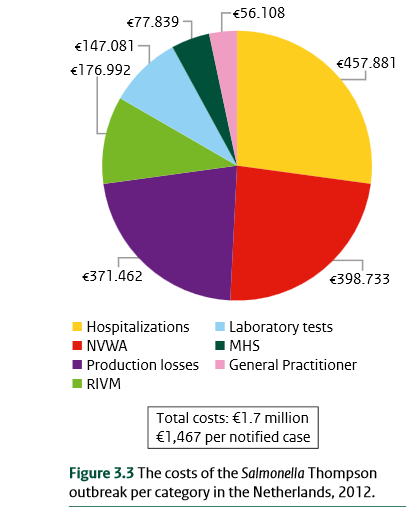During the outbreak in 2012, 1,149 cases were reported, which were identified using laboratory diagnostics, said Rijksinstituut voor Volksgezondheid en Milieu (RIVM).
The highest cost categories concerned the efforts by the Netherlands Food and Consumer Product Safety Authority (NVWA) to locate the source of the contamination, and hospitalisation of seriously ill patients.
Understanding costs for future and optimize resources
The annual State of Infectious Diseases 2014 report said understanding costs of illness helps in planning for future outbreaks and allocating public resources.
The cause was smoked salmon processed at a single Greek production site of a Dutch fish producer.
Two hundred and thirty people were hospitalized and four elderly patients were reported to have died.
Salmonellosis is not a notifiable disease in the Netherlands. Many people would not go to the doctor and, if they did, a laboratory test would not always be performed.
The €1.7m figure was based on laboratory-confirmed cases only.

To estimate incidence of such foodborne diseases, cases notified by laboratories within the Dutch laboratory surveillance network were corrected with estimates from Dutch population studies.
This correction leads to an estimated 22,000 people who would have had S. Thompson, which is about 20 times higher than the laboratory-confirmed cases.
“Adjusting the cost estimates for this underestimation, the total costs would be substantially higher (€11m in total). In this figure, long-term complications are included,” said the report.
Breakdown of estimated costs
The most important cost category was hospitalization, caused by the severity and complications due to the infection.
“Risk assessment, inspections and tracing back food products conducted by the NVWA were time consuming and also led to substantial costs. Production losses and laboratory investigations led to significant costs,” said the report.
“Costs for GP consultations and hospitalizations were estimated to be €56,108 and €457,881, respectively.
“Test costs, entailing PCR, culture and susceptibility assessment, were estimated at €147,081, whereas productivity losses were approximately €371,462.
“Outbreak investigation and outbreak management costs were the largest for NVWA (€398,733) for trace-back and risk assessments, followed by RIVM (€176,992), split more or less equally between laboratory costs and investigation.”
Underestimation explanation
RIVM said the measured outbreak costs are an underestimation as data restrictions did not allow for estimation of long-term health care complications of the S. Thompson infection.
“The cost analysis also did not include productivity losses for the Dutch fish company and supermarket chains after placing the production on hold and recalling contaminated smoked salmon from supermarkets,” said the report.
“In the months after the outbreak, supermarket chains reported a revenue decrease, valued at €10m, as consumers bought less salmon.
“The costs of a nationwide evaluation of the S. Thompson outbreak performed by the Dutch Safety Board were not included in this study, nor were the continuing costs incurred by the NVWA after the acute outbreak phase.
“In addition, costs incurred by the Hellenic Food Authority, EFET, which was responsible for the inspections at the Greek production site, were not taken into account, nor were the costs incurred by other Food Safety Authorities involved in the international recall of the product.”
The NVWA performed a trace-back investigation based on the results of a case-control study.
“Where possible, supermarkets and patients were contacted and food samples were taken,” it said.
“Other outbreak response activities concerned the microbiological investigations both at the RIVM and at regional public health laboratories, advising the public and the administration of a questionnaire among cases by municipal health services, as well as activities related to extensive media attention.”
